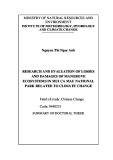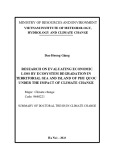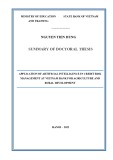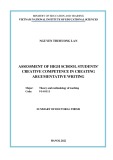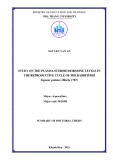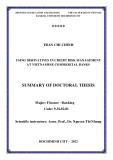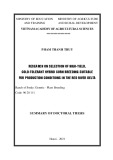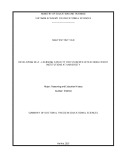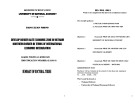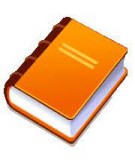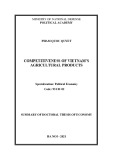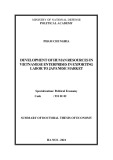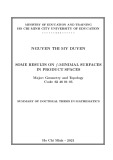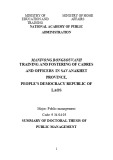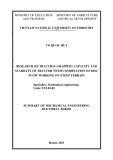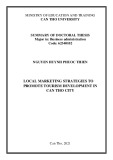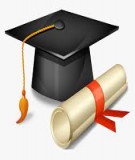MINISTRY OF EDUCATION AND TRAINING
VINH UNIVERSITY
PHAM NGUYEN HONG NGU ORGANIZING COGNITIVE ACTIVITIES
FOR STUDENTS THROUGH EXPLORING FUNCTIONS OF THE
PRACTICAL SITUATION IN TEACHING MATHEMATICS AT HIGH
SCHOOLS
Major: Theory and methods of teaching Mathematics
Code: 9140111
SUMMARY OF DOCTORAL THESIS ON EDUCATIONAL SCIENCE
NGHE AN, 2020
INTRODUCTION
1. The reason to choose this topic In recent years, our education has been changing drastically to keep pace with international education development. The teaching method which focuses on transferring knowledge and skills is not popular anymore. Now, we need to tend to build intellectual development abilities for students.
to that: “Need from knowledge provision
fundamental knowledge meeting
Resolution No. 29-NQ / TW in November 4, 2013, approved by the 8th Central Conference Session XI on fundamental and comprehensive renovation of education and training, stated to transform education comprehensive development of learners' capabilities and qualities. Learning is linked with practice, theory associated with reality. Schools need to be combined with family and social education”. The goals of the High-School Education Program in the resolution are defined as "focusing on intellectual and physical development, forming personal qualities, citizen capacity, detecting and fostering talents and career orientation for students; Improving the quality of comprehensive education, focusing on education about ideals, traditions, ethics, lifestyles, foreign languages, informatics, competence practical skills and abilities to apply knowledge to real life; Developing creativity, self-study and encouraging lifelong learning; Completing the high-school education program after 2015; Ensuring that students at secondary schools (finishing 9th grade) have the requirements after secondary school. High school students must be accessed to career orientation or well-prepared for post-high-school education; Improving the quality of compulsory education and implementing 9-year compulsory education after 2020”.
Accordingly, the 2018 General Education Program stated that the goals of high- school education in Vietnam are to "Help students develop themselves physically and mentally; become active and confident learners, and be able to choose career and maintain lifelong learning; have good qualities to become responsible citizens, cultivated, hard- working and creative workers so as to meet the personal development needs and requirements in building and protecting the nation in the era of globalization and new industrial revolution”.
Currently, Math Education in our country has been changing in the direction of associating mathematical knowledge with practice, paying attention to abilities applying mathematical knowledge learned by students. This is seen through the goals of the new Math Education and Development Program issued by the Ministry of Education and Training on December 26th, 2018. Specifically, Math helps form and develop students’ basic qualities, capabilities and Math competence namely mathematical thinking and reasoning, modelling, abilities to solve math problems, abilities to communicate math, abilities to use mathematical tools and means; developing key knowledge and key skills and creating opportunities for students to experience and apply mathematics to real life. Math education creates a connection between mathematical ideas, between mathematics and other sciences and between mathematics and real life.
This goal is completely consistent with the current trend of mathematical assessment in the world by educational organizations and programs such as Organization for Economic Cooperation and Development (OECD) with 15-year-old Student Assessment Program in International (PISA), Science Technology Engineering Maths (STEM), Trends Mathematics and Science Study (TIMSS), etc. These programs,focus on assessing mathematical competence and use mathematical knowledge to explain practical activities; focus on abilities to modelize practical phenomena using mathematical language and
1
notation, and to apply mathematics to practice.
Those goals should be implemented in teaching mathematics with the idea that mathematics education should be associated with practice, mathematics education should be directed to educating dialectical materialist worldview of students. Teachers in the teaching process, need to organize many cognitive activities for students to experience the interactive learning, apply their mathematical knowledge to the process of creating new knowledge; avoid teaching mathematics at high schools abstractly, lack of practical orientation.
The above issues are the premise to guide us to implement the topic: Organizing cognitive activities for students through exploring functions of the practical situation in teaching mathematics at high schools.
2. Aims and objectives of the research The thesis aims to find out the functions of practical situations, design practical situations, apply designed practical situations to organize cognitive activities for students in the process of teaching mathematics at high school, contribute to improving the quality of mathematics teaching at high schools towards student’s competence development.
3. Scientific hypothesis It is possible that finding out practical situations and using mathematical representations as an intermediary will drive students to activities of exploring, discovering, and achieving knowledge, contributing to the effective improvement of cognitive activities in learning mathematics at high school. 4. Research questions To fulfil the objectives of the research, the thesis focuses on answering the following questions:
4.1. What is a practical situation in teaching mathematics? 4.2. Which functions of practical situations in teaching mathematics are of
developing learners' competences?
4.3. How can we design and build practical situations in mathematics teaching? 4.4. How can students take part in cognitive activities and perform the functions of
practical situations in mathematics learning?
5. Focus and scope of the research 5.1. Focus of the research The research focus on the ways of designing and organizing cognitive activities for
students through exploring the functions of practical situations in teaching mathematics.
5.2. Scope the research The scope of the research is mathematics education through exploring the functions
of practical situations at high school in Vietnam.
6. Research methods The thesis uses theoretical research methods, observational surveys, synetheses of
pedagogical experiences and experiments. 7. New contributions of the thesis + In theory, the thesis is: - Proposing an approach to practical situation in teaching mathematics at high schools. Clarifying the functions, the roles of practical situations such as the function of stimulating students to access to the knowledge, the funtion of discovering the laws of exploring mathematical rules, the funtion of consolidating the knowledge, the funtion of explaining the simulation of practical phenomena to exploit different applications of mathematics in practice, and the funtion of creating student’ mathematics culture;
2
- Clarifying the viewpoint of organizing cognitive activities for students through practical situations. Proposing some cognitive activities in teaching and learning mathematics through practical situations such as getting new knowledge, consolidating knowledge, and applying mathematical knowledge.
- Clarifying outstanding difficulties teachers have in designing and organizing
mathematics teaching in practice. + In practice, the thesis is: - Clarifying how to utilize the funtions of practical situations and provide new illustrations in practice.
- Proposing processes for designing practical situations, organizing cognitive activities in typical situations composed of teaching mathematical concepts, theorems, and rules. Developing some new illustrative examples for these processes.
8. Issues in defence The theoretical and practical approaches the thesis focus on: - Explaining the difficulties teachers face in designing and using practical situation when teaching mathematics at high schools, and that students have in connecting mathematics with practice, clarifying the roles and functions of practical situations in teaching mathematics;
- Analysing the principles of designing practical situations, clarifying the process of designing practical situations in teaching mathematics; - Clarifying the process of organizing cognitive activities for students via the
designed practical situations;
- Assessing the feasibility of the thesis through pedagogical experiment. 9. Structure of the thesis In addition to the introduction, conclusion and recommendation, the thesis structure
includes the following main contents:
Chapter 1. Theoretical and practical background Chapter 2. Designing practical situations in teaching mathematics at high schools Chapter 3. Organizing cognitive activities via practical situations in teaching mathematics at high schools Chapter 4. Pedagogical experiments
3
Chapter 1 THEORETICAL AND PRACTICAL BACKGROUND
1.1. Theoretical background 1.1.1. Literature review We approach international studies (RME, PISA, NCTM, STEM, TISS, ...), domestic studies (Bui Huy Ngoc, Phan Anh, Nguyen Ngoc Anh, Vu Huu Tuyen, Ha Xuan Thanh, ...) to clarifying the trends of mathematical research in association with reality, modeling, and renovating education according to the current capacity development orientation for students. Most of these studies confirm the great role of linking mathematics with practice up to now, and indicate that teaching mathematics should be tied to the real-life context of students to develop problem solving competence at different levels of education. However, there has not been any detailed and profound research on practical situation in teaching mathematics as a means to search for mathematical rules, as well as designing process of practical situation and organizing cognitive activities for students in teaching mathematics.
1.1.2. Terminologies used in the thesis + Situations in teaching mathematics are defined as the situations containing mathematical content to be discovered, that are designed or redesigned by teachers, and integgrated with learning tasks so that students can achieve mathematical knowledge by doing the tasks.
+ Practical situations in teaching mathematics are understood as the situations deriving from practice of our daily life in which mathematical contents or relationships can be found, designed or redesigned, in accordance with the lesson objectives in order for students to take part in these situations and acquire mathematical knowledge.
1.1.3. Approaches of Practical Situation in mathematics teaching Practical situations are approached from different angles, including cognitive methods in teaching mathematics, the connection between mathematical content and practice through modelization, assessment and evaluation, integrated teaching trend, math cultural education for students. Because they all have in common that mathematics is derived from practice and today's teaching perspective is to consider the process, not just the result of learning activities.
1.1.4. Functions of practical situation in teaching mathematics In this section, we propose, analyze and clarify the functions of practical situations in teaching mathematics including: motivating students to approach practical situations and get inculcating knowledge; laws, searching mathematical rules; knowledge, detecting explaining the simulation of practical phenomena to exploring different applications of mathematics in practice; contributing to creating students’ mathematical culture.
1.1.5. Mathematics cognitive activities Theoretical and practical researches, show the relationship between the functions of practical situations and the cognitive activities of students in mathematics lessons. Therefore, utilizing the functions of practical situations in teaching mathematics, should be implemented through mathematical cognitive activities. In the thesis, mathematical cognitive activities is understood as "The thinking process leading to the acquisition and comprehension of mathematical knowledge, the identification of causal and other relationships between concept, relationships, mathematical laws, etc thereby mathematical knowledge may be applied to solve practical problems”.
In the thesis, the cognitive activities associated with practical situations in teaching mathematics including: - Providing new knowledge; - Consolidating knowledge; - Applying
4
mathematical knowledge such subactivities as observation, assimilation, moderation, modelization, discovery and object transformation.
Organizing cognitive activities for students in teaching mathematics is considered the teachers’ performance of the most necessary mathematics teaching tasks to students think and achieve mathematical knowledge actively and creatively.
We also propose organizing cognitive activities for students in teaching mathematics through utilizing the functions of practical situations is the teachers' design of practical situations providing activities for students so that these cognitive activities can stimulate their learning needs, understand the significance of mathematical knowledge, and applying mathematical knowledge into practice.
1.2. Practical Basis 1.2.1. Practical element in the current textbook program in Vietnam Based on the surveys of the current situation of Vietnamese textbooks, we find that in the current textbooks in Vietnam, the authors of books have some historical stories, tables, figures, drawings, examples, problems with practice to motivate students to study. However, according to Nguyen Chi Thanh's opinion: "there are few practical problems", not focusing on the application of math to solve a practical problem after each lesson. We also agree with Ha Xuan Thanh's opinion that exercises, examples in textbooks of high school mathematics, are mainly divided into two categories: pure mathematical problems and practical problems; in which the practical problems account for a very low rate (4.6%) in the total number of exercises, even for highly applicable such as inequality, Probability statistics,…
Therefore, we think that reviewing and supplementing practical element in the high school education programs in general and mathematics education in particular in our country at this time is urgent that requiring the cooperation and contribution of the educational management, teachers and the whole society. It is praiseworthy that in the 2018 General Education Program in general and the 2018 Mathematics Education Program in particular, the program researchers emphasized the important meaning of practical connection in teaching mathematics, showing in requirement on skills and competencies for students from primary to high school in the new mathematics program through hands-on activities (Elementary to high school) and thematic activities (High school level). 1.2.2. Surveying the real situation of teachers and students' awareness of practical situation in teaching mathematics at high schools
In order to understand the real situation of teachers 'and students' awareness about practical situation in teaching and learning math, we designed the questionnaire (see the appendix) and conducted a survey with 134 teachers and 1057 students in high schools in many cities and provinces nationwide such as Quang Nam, Quang Ngai, Da Nang, Gia Lai, Kon Tum, Dac Lac, Quang Binh, Nghe An, Ha Tinh, Ninh Thuan, ...
- On the teacher's side, we consider the teacher's perception of practical situation, teacher difficulties when using practical situation, going over the regular lesson of the teacher as well as the awareness and experience of the teacher in building practical situation. Based on the survey results as well as consulting experts, reputable educational researchers, we recognize the difficulties that teachers face during the process of experimenting, exploring, building practical situation in teaching mathematics following these reasons:
Firstly, the limitation of teachers' awareness of theoretical basis. They do not know where to start to be able to model a mathematical knowledge. The nature of mathematics is abstract so a mathematical knowledge can be concretized in many different directions and teachers do not know what practical object to choose to represent that mathematical knowledge.
5
Secondly, the concept of teaching mathematics tied to the practice of teachers is different; they do not know whether the situation of teaching mathematics in practice is the situation associated with the phenomena that occur in reality or only internally in mathematics, or only in the relationship between mathematics and other subjects.
Thirdly, most teachers teach math exactly like what are in textbooks, but in the current textbooks, the number of problems containing practical contents, or practical simulations, is both small in number.
Fourthly, teachers have few researches on mathematical history, so they have not really seen the origin of mathematics, the need for developing mathematics, nor the ideology of methodology in teaching math which is teaching the relationships between chapters, sections, spaces and quantities.
Another shortcoming of mathematics teacher nowadays is not paying adequate attention to their lessons; there are few activities in discussing and cooperating between teachers on a specific problem or teaching situation.
- On the student's side, we collected students' perception of the necessity and need to understand the application of mathematical knowledge in practice.
Based on the result of the student survey, we found that: Most of the students, when asked, want to know which mathematical knowledge learned in high school can be applied in practice, how to apply it (more than 89%). There are only 41 students, accounting for 3.9%, do not want to know learning math for what, or to learn math because it is a compulsory subject and 6.6% of the students are indifferent, no opinion. This shows that students are very interested in what to learn math for. Currently, math is a main, compulsory subject in high school, but in reality, students do not understand why to learn math than facing exams. When surveyed, 47.4% of students said they were regular, 15.8% of students very often used math in their daily activities. However, they only use common summation, subtraction, multiplication, division, but have not seen the use of other mathematical content such as functions, derivative, integral in practice. According to them, these are luxurious content and in fact never be used, although many students are studying grade 12th (they have learned quite a lot of mathematical applications such as the application of integral and numerical series). There are 39 students who think that they do not use any mathematical knowledge in their work, daily life, even simple arithmetic calculations (!?) Most students think it is very important to have skills to apply math into daily work; This is entirely consistent with question 2 about the desire to apply math knowledge in practice. However, students think that they rarely learn math through practical situation. The voluntarily solving of actual problems is very small, accounting for 32.8% of the surveyed students. Nearly 70% of surveyed students said that they rarely and often do not find out the real problems themselves if they are related to mathematics. Most students like to learn math through practical situation, only 3.4% do not like it and 5.5% have no answers yet.
6
Conclusion of chapter 1
In chapter 1, we highlighted: - Overview of a number of research works of domestic and foreign authors about the relationship between mathematics and practice, the necessity of mathematics in practice, the situation of teaching mathematics associated with reality, the use of mathematical modelling in teaching mathematics associated with practice, the contents of educational transformation in association with practice, the assessment and tendency to apply mathematical knowledge into daily life of students, assessment of students' mathematical understanding.
- The concept of practical situation in teaching mathematics, clarifying the functions of situation in teaching mathematics at high schools according to the author's approaches (Cognitive methodology approach, approach to the content connecting mathematics with practice through modelling, approaching the trend of testing and assessing, approaching the trend of integrated teaching, approaching mathematical cultural education for students).
- Difficulties of teachers, students in teaching and learning mathematics associated with reality; assessing the awareness of teachers and students about the need, desire to teach and learn math associated to practice. We also identify the causes that lead to difficulties for teachers in experiencing, exploring, and building practical situations such as: time constraints, difficulties in finding relationship between mathematical knowledge and practical facts, the difficulty of transforming the content of mathematics to be taught into real model, ...
- The concept of cognitive activities in teaching mathematics, analysing cognitive activity of students into component activities: observation activities, object transformation activities, modelling activities, facilitation activities, assimilation activities. At the same time, the thesis also mentioned the positive teaching methods that teachers need to use to organize cognitive activities for students (this will be specified in the examples of organizing cognitive activities for students in the chapter 3 of the thesis).
7
Chapter 2 DESIGN OF PRACTICAL SITUATIONS IN MATHEMATICS TEACHING AT HIGH SCHOOL
In chapter 1, the thesis presented the necessity of connecting practice with mathematics in teaching, the functions of practical situation in teaching mathematics; as well as the difficulties that teachers are currently facing in order to experience, explore, and build practical situation. Based on that basis, the thesis designed a few practical situations in teaching mathematics to support teachers in teaching mathematics associated with their practice.
2.1. Principles of designing practical situation in teaching mathematics Principle 1: The design of practical situation must ensure the contents of the current textbook programs. Principle 2: The design of practical situation in teaching mathematics must be
suitable with the real life of students Principle 3: Practical situation is designed to ensure creating an active environment for all students to participate in the learning process to form mathematical knowledge. Principle 4: The design of practical situation must be suitable with the level,
capacity and psychological characteristics of students
Principle 5: The practical situation design should clearly show the pedagogical intention of the teacher, evaluating the ability to understand and apply math to practice of students
2.2. Designing process of practical situation in teaching mathematics Based on theoretical and practical research in chapter 1, referring to the researches on the use of practical factors in teaching algebra, calculus, geometry of previous researchers, inheriting the design process of learning case in previous documents, in this thesis, we propose the process of designing practical situation in teaching mathematics including 6 steps as following:
Step 1: Researching the goal and lesson content Teachers need to study deeply the curriculum in textbooks, teachers' books, reference books to identify lessons, identify standards of knowledge, skills, competencies and qualities that students will gain after studying. Identifying the key knowledge of lesson, the knowledge that students have, the knowledge that students need to be supplemented to understand the lesson; identify the skills that students are having, the skills that students need to gain, what is the applications of lesson in real life.
Teachers need to study textbooks to review the situations in textbooks if they have ensured the connection between teaching and practice, considering which mathematical knowledge can integrate, adjust and supply practical elements in teaching. From there, teachers need to determine what knowledge is capable of designing into a situation, as well as the necessity and benefits of the situation with the lesson objectives. At this step, the teacher also envisages what functions of the practical situation can be gained to guide the design of practical situation.
Step 2: Observing practices After identifying the lesson objectives, teachers must observe real life. For example, they can go to local production facilities to search and select practical models related to the necessary content to design the situation in step 1, which is suitable to their teaching conditions. At this step, empirical knowledge is very beneficial for teachers, based on their existing experience, teachers will quickly determine which practical form contains
8
mathematical knowledge in step 1 to observe. Sometimes, teachers can observe and refer to practical models that have been developed by educational researchers for reference.
Step 3: Selecting a model that is suitable for the teaching goal, building situation Teachers select a mathematical model from those they observed that are suitable for teaching purposes to build the situation. They should select the knowledge and skills that students should gain to outline the situation to be built.
Teachers identify teaching objectives in accordance with the model (forming, applying, reinforcing concepts or theorems, rules, ...) to build situation based on collected information. Situation needs to be built systematically and logically, which is based on the principles of situation construction, ensuring accuracy, specificity, not too hard, not too easy for students and showing the functions of situation in the teaching process later.
In the process of building situation, teachers need to analyze which is the cognitive level, experience, psycho-social characteristics of students to predict and confirm the difficulties of situation or the obstacles that students have to overcome. Questions and necessary technical means to support students in solving situations.
Step 4: Discussing and adjusting the situation Teachers can share the situation they have just built with colleagues, research groups to receive valuable suggestions about the content, rationality, coherence, appropriateness of the situation. Through seminars or exchanges, interviews with experienced teachers to clarify the necessary requirements of situation design such as: Does situation clarify the meaning of knowledge to be taught? Does situation ensure excitement, stimulating for students? Is situation close to students' understanding? Can students easily convert situation into math model? Can students solve problem in mathematical model of situation? Can students explain the reality when there are results from the model? Referring to the predictions of teachers in the subject group and experienced teachers about difficulties and correct the situation.
Step 5: Testing the situation Teachers conduct a test case which has been edited in step 4 on a small group of students. During the testing process, teachers need to observe to answer the following questions: - Are Students interested in the situation?, - How many questions can students solve in the situation?, - Can students modelize the situation?, - Have students seen the meaning of mathematical knowledge hidden in the situation ? From there to consider the feasibility of the situation, helping students if necessary, to solve the situation. In this step, students must carry out the process of modelling from practical situation to the mathematical problems, solving problem which the situation gives.
Step 6: Confirming the situation Based on the results observed in the testing of the situations, the teacher will confirm whether the situation is feasible or not, if the student solves the situation (may need the support of the teacher), we accept the situation, otherwise in case students cannot solve situations (even though the teacher has helped), we can replace and redesign situations.
2.3. The stages in teaching mathematics that are necessary to apply the process 2.4. Designing practical situation in teaching mathematics at high schools Based on a 6-step process, we have conducted to design some practical situations in teaching mathematics, used in teaching concepts, theorems, and rules. Due to the limited research conditions, these practical situations are carried out to discuss and collect comments through seminars at the division of method of teaching Mathematics, Department of Mathematics at Quang Nam University; at the same time, collecting feedback (via email) from high school teachers at Nguyen Duc, Le Quy Don and Duy Tan schools in Quang Nam
9
province; Nguyen Trai and Tran Cao Van schools in Khanh Hoa province; Le Thanh Phuong and Phan Boi Chau schools in Phu Yen province; Duy Tân school in KonTum province; Nguyen Cong Tru school in Quang Ngai province; Le Quy Don school in Binh Dinh province; Le Duan school in Dak Lak province; Nguyễn Chí Thanh school in HCM city. Because of limited conditions, we have only tried to teach practical situation at a group of students of class no. 11/3 at Nguyen Duc High School (implemented by teacher: Cao Thi Lanh), and a group of students of class no. 10C1 and class no. 12C1 of Le Quy Don high school (by teacher: Huynh Thi Thu Phuong) in Quang Nam province. 2.4.1. Practical situation used in conceptual teaching teaching Example 2.1. Designing conceptual situation "Straight
line perpendicular to plane" in lesson " Straight line perpendicular to plane" Geometry Textbook 11, page 98
Step 1: Research the goal and lesson content We conduct research on textbooks, teachers' books, standard knowledge materials for high school math skills, documents to guide the implementation of knowledge standards of grade 11th to determine the content of knowledge and skills that students have as well as the knowledge, skills students need to gain in this lesson are as follows: -About knowledge: Knowing the definition and condition of straight line perpendicular to the surface, perpendicular projection, Bisector plane, -About skill: Knowing how to prove that straight line is perpendicular to the surface, straight line is perpendicular to other straight line, and determining normal vector of a surface, perpendicular projection, applying the theorem of 3 perpendicular lines, determining the middle angle of straight line and the surface.
We conducted a study on the textbook of grade 11th to find that. To give motivation into the lesson, the textbook mentions the image of the robe which is perpendicular to the floor that talks about the image of the straight line perpendicular to the floor, while not mentioning any practical elements in the theorem, properties...
We think that we can design practical teaching situations in the following activities: - Concept forming activities, - Theoretical formation activities, - Theoretical manipulation activities, - Problem solving activities. Step 2: Observing reality We observe practically that there are quite a lot of images about straight line perpendicular to plane in construction (plumb line), in design (revolving door), the image of flagpole in school yard, image of table legs, chair legs, picture of notebook on the table, ...
Step 3: Selecting the model that is suitable for the teaching and building goals We choose a model of a notebook on the table with a pen. Teaching objective is the
concept of straight line perpendicular to a surface. Building the situation as following:
10
The perpendicular situation 1. Please observe the following image and can you comment on the relative position of the "nape" of the notebook and pen? Explain? 2. If there is a ruler on the table, what is the relative position between the "nape" of the notebook and the ruler? Explain? 3. What do you comment on the "nape of the notebook" with
the tabletop?
Step 4: Discussing and adjusting the situation Most of the interviewed teachers said that the situation has clear, logical, and realistic goals. However, we still receive the following comments: Need to clarify which "nape line" in the situation is? Questions need to change the phrase "relative position" to "calculate the angular measurement" between two straight lines so that students use old knowledge and definition approaches.
FEEDBACK ABOUT THE REQUEST OF PRACTICAL SITUATION IN TEACHING STRAIGHT LINE PERPENDICULAR TO PLANE
Request Other comments Agree Vote (Ratio %) Disagree Vote (Ratio %)
teaching objective of 121 (90%) 13 (10%)
104 (77%) 30 (23%)
99 (73%) 35 (27%)
the 0% 134 (100%)
0% 134 (100%)
in is close to 130 (97%) 4 (3%)
is recommended 95 (70%) 39 (30%)
- Can use images of straight line perpendicular to plane such as flagpoles, table legs. - Questions should focus on calculating the angle between two straight lines instead of determining relative to help students, position, mobilize old knowledge and approach new concepts. - Clarify what is the "nape line"? Can explain the picture. - During the teaching process, to use it dynamic software to show the angle between the nape line and the line lying on the table. 105 (78%) 29 (22%)
121 (90%) 13 (10%)
situation 129 (96%) 5 (4%) ensures to stimulating The situation is clear The figures in the situation are logical and accurate The question in situation is fit with students The situation can be used to teach concepts The situation can clarify on the meaning of knowledge to be taught The situation students' understanding The situation can easily be converted to a mathematical model Students can solve problems in the mathematical model of situation Students practical explain problems after completing the model The excitement, students
Based on that, we agree to adjust the situation as follows:
The perpendicular situation (Adjusted)
11
1. Please observe the following image and indicate the corner of the "nape line" (red arrow) of the notebook and pen?
2. If there is a ruler on the table, what is the angle between the "nape line" of the notebook and the ruler? 3. What about the angle between the "nape line" of the notebook and the other straight lines on the table?
4. Predicting the relative position of the "nape line" of the notebook with the tabletop?
'd
Step 5: Testing the situation Observing students’ experience in the situation, we found that the students could not answer question 1. In question 2, students said that "if the ruler is close to the nape line of the notebook, the angle will be equal to 900, other straight lines cannot measure the angle”. However, the students all predict the "nape line" perpendicular to the tabletop but could not explain why. We support students in solving problem and approaching definition, through the following questions:
Question 1: Ignoring the factors of thickness, width of notebook, pen, ruler, table, ... called "the nape line of the notebook" is the straight line d, the notebook . part, the tabletop is plane, the pen is straight line Please determine the mathematical model of practical situation. answer: Given
whose is Expected ABCD ADEF ,
'd
rectangular ) d AD ( . )a ( and plane two intersection d
'
∑, d d
planes Determine the angle between line containing line
ABCD
(
)
DC d
/ /
'
? around the axis so that
AD
∑
'
, DC 90 =
d=
.Then .
)a (
d
and any lines inside ?
d
Question 2: How to determine the middle angle Expected answer: Rotating plane ∑ 0 d d , Question 3: What is the angle between line Expected answer: Do the same as above, we determine the angle between line and
)a (
090
any straight line in is
)a (
d
?
Question 4: What is the relative position of line Expected answer: Line d
with every line in )a ( . perpendicular to every line in )a ( ? Question 5: Predict the relative position of d and plane
)a (
.
Expected answer: Line d perpendicular to plane Step 6: Confirming the situation Through the process that we observe while students test the situation, we realize that although there are students who have not solved the situation. Thanks to the teacher’s support, students have solved the situation completely and they confirm the definition by themselves; so the situation is feasible and can be applied in teaching. 2.4.2. Practical situation used in theoretical teaching Example 2.5. Design teaching situation for theorem 3 about "sum of infinite
12
backward geometric progression" in Algebra and Calculus textbooks 11, page 102
Step 1: Research the goal and lesson content We conduct research on textbooks, teachers' books, standard materials for high school math skills, documents to guide the implementation of knowledge standards of grade 11th to determine the contents and skills that students have as well as the knowledge, skills students need to gain in this lesson are as following: - Identifying geometric progression, - Determining the general terms, the formulas for calculating sum of geometric progression, - Applying geometric progression in practice.
We also find that in the "geometric progression" of the textbook, it refers to the situation that suggests the definition of geometric progression: dividing paddy on the chessboard, for example, Ecoli cells in terms of general terms, without the practical situation of theorem of sum of infinite backward geometric progression. So, in this lesson, teachers can design cases that teach theorems, solve problems, ...
Step 2: Observing practices Teachers conduct practical observations and can find the contents containing mathematical knowledge of geometric progression such as: - Methods of calculating interest rate, - Rules of growth of species and plants in Biology, - In other sciences such as Physics, Chemistry, ...
Step 3: Selecting the model that is suitable for the teaching and building goals We choose the model of painting a cardboard, the goal of teaching the theorem of
infinite backward geometric progression - to build practical situation as following:
The situation: Paint the board There is a rectangular piece of cardboard, divided into 4 equal parts, coloring one part of the divided cardboard; in the remaining 3 parts, select a part and divide it into 4 equal smaller parts, then keep painting a small part as above. Repeating this process until the cardboard is completely painted.
1. After 3 divisions and paintings, how many parts has the board been painted? 2. How many times can the board be divided and painted? 3. Calculate the painted area of the board? Step 4: Discussing and adjusting the situation Most of the feedback of teachers evaluate the situation which is suitable with the practice, but if it is possible to search for an image in reality, the situation will be more practical (Although through discussion, it is difficult to bring an image of infinity into reality so we receive sympathy from teachers).
13
Requirement Other comments FEEDBACK ON THE REQUIREMENT OF PRACTICAL SITUATION IN TEACHING THE TOTAL THEORETICS OF INFINITE BACKWARD GEOMETRIC PROGRESSION Disagree Agree Vote Vote (Ratio %) (Ratio %)
it possible 121 (90%) 13 (10%)
in the situation are 104 (77%) 30 (23%)
99 (73%) 35 (27%)
in 0%
to - Is change another image of infinity in practice practical into situation? - Should illustrate the drawing the situation for students to easily visualize 0% 134 (100%) 134 (100%)
130 (97%) 4 (3%)
95 (70%) 39 (30%)
in 105 (78%) 29 (22%)
121 (90%) 13 (10%)
129 (96%) 5 (4%) The teaching objective of situation is clear The figures logical and accurate The question in situation is fit with students The situation can be used to teach concepts The situation can clarify on the meaning of knowledge to be taught The situation is close to students' understanding The situation can easily be converted to mathematical model Students can solve problems mathematical model of the situation Students explain practical problems after completing the model The situation ensures excitement, stimulating to students
We have adjusted the situation as follows:
The situation: Painting the board (Adjusted) There is a rectangular piece of cardboard, divided into 4 equal parts, painting one part of the divided cardboard; in the remaining 3 parts, select a part and divide it into 4 smaller equal parts, then keep painting a part as above; Repeating this process until the cardboard is completely painted.
1. After 3 divisions and paintings, how much of the original area is painted? 2. How many times can the board be divided and painted? 3. Calculate the painted area of the cardboard?
Step 5: Testing the situation We conducted a test on a group of students. Some students only answer question 1,
+
=
+
21 64
1 2 4
1 4
1 3 4 the board could be divided and painted infinitely, but they could not calculate the area of the board that would be painted infinitely. In particular, a student found that the painted area is one third of the original board.
the area after 3 times of painting is of the board. Some of the students said
1u
. Calculating the painted area of
1u
We support students in solving the situation with the following questions: Question 1: Let the painted area in the 1st time is the board in the second, third and fourth painting times based on .
14
u 1
u 1
1 4
1 2 4
The expected answer: The area of the second painting is . The third time is ,
u 1
1 3 4
the fourth time is respectively .
Question 2: After 3 times, what is the painted area?
+
+
=
=
u 1
u 1
u 1
u 1
1 4
1 2 4
21 16
21 64
Expected answer: After 3 times painting of the board.
Question 3: How many times can the board be divided and painted, calculating the
total painted?
S
... + +
=
+
u 1
u 1
n
1
1
1 4
(1) painted area after n times is Expected answer: It is possible to divide and paint the board up to n times, and the 1 u- n 4
1 4
Question 4: Multiplying the two sides of the above expression with , what we
S
=
+
... + +
+
have?
n
u 1
u 1
u 1
u 1
1 2 4
1 1 n - 4
1 n 4
Expected answer: (2)
1 4 nS
1 4 1u through two equations (1), (2)?
1
-
Question 5: Find by
S
=
=
nS
u 1
n
lim n ®¥
1 3
1
-
1 n 4 1 4
Expected answer: and
Question 6: Comment about the painted area of the board in the first, second, third,…? Expected answer: The painted area at painting times set up the geometric progression
1 4
1 4
with the first term is , the common denominator is .
1u
1
-
S
=
Question 7: Predicting the theorem of sum of infinite backward geometric progression with the first term
u 1
n
1
-
Expected answer: (This is the
, the common denominator is q? 1 n q 1 q
content of the theorem).
Step 6: Confirming the situation Through the process of observing students solve the situation, we realize that, although they have not solved the situation by themselves, but under the guidance of teachers, they have discovered the theorem of calculating sum of infinite backward geometric progression. Therefore, the design of this practical situation is feasible and can be applied in teaching.
2.4.3. Practical situations used in teaching rules Example 2.13. Building the situation of forming mathematical inductive method for students, in the lesson of mathematical induction method of Algebra and Calculus
15
textbook 11, page 80
Step 1: Research the goal and lesson content We conduct research on textbooks, teachers' books, standard materials for high school math skills, documents to guide the implementation of knowledge standards of grade 11th to determine the contents and skills that students have as well as the knowledge, skills students need to gain in this lesson are as following: - Students understand mathematical induction method, - Students know how to solve some simple problems by induction, - Students understand how to try and predict the rules, proved by induction.
Step 2: Observing practices We rely on our empirical knowledge to observe normative, inductive practical phenomena in the case of large quantity calculation such as calculating the sum of many terms, calculating the number of vertices, diagonal lines of n-edge polygon, ...
Step 3: Selecting the model that is suitable for the teaching and building goals Here, we choose the Facebook connection model to design, use in formulating
inductive proof. The situation is designed as following:
The situation: Facebook connection Currently, Facebook is quite popular in Vietnam and around the world. It is found that for every 2 people there will be 1 connection on Facebook, every 3 people have 3 connections, every 4 people have 6 connections on Facebook, ... Knowing that, Vietnamese population which is older from 15 years old as of July 1, 2016 is 54.4 million people, the question is how many adults in our country have Facebook accounts connected to each other?
Step 4: Discussing and adjusting the situation When discussing this situation in the subject division, many teachers think that the situation is quite general, it will be difficult for students, it is necessary to adjust the data so that students can easily calculate. Adjusting some words and figures that need updating (2019 instead of 2016), ...
FEEDBACK ABOUT PRACTICAL SITUATION’S REQUEST IN TEACHING INDUCTIVE RULE
Requirement Other comments Agree Vote (Ratio %) Disagree Vote (Ratio %)
120 (89%) 14 (11%) in 2016
112 (83%) 22 (17%)
the 118 (88%) 16 (22%)
134 (100%) 0%
the 128 (95%) 6 (5%)
133 (99%) 1 (1%)
easily be situation can 109 (81%) 25 (19%)
- Should change the figures to 2019. - Adjusting the phrase situation in to the meaning clarify be "there may a connection Facebook two any between (assuming people" everyone uses Facebook). - Dividing questions in the situation into many ideas so that students The teaching objective of situation is clear The figures in the situation are logical and accurate The question in situation is fit with students The situation can be used to teach concepts The situation can clarify on meaning of knowledge to be taught The situation is close to students' understanding The converted to mathematical model Students can solve problems in 120 (89%) 14 (11%)
16
130 (97%) 4 (3%)
132 (98%) 2 (2%) can gradually approach the situation. - Can we use the situation in formulating function definition? mathematical model of the situation Students explain practical problems after completing the model The situation ensures excitement, stimulating to students
The situation after discussion is adjusted as follows: The situation: Facebook connection (Adjusted) Currently, Facebook is quite popular in Vietnam and around the world. It is found that for every 2 people there will be 1 connection on Facebook, every 3 people have 3 connections, every 4 people have 6 connections on Facebook, ... Please answer the following question: 1. Our class has 42 students, so how many Facebook connections can there be, assuming all students in the class have a Facebook account?
2. Predicting mathematical rules for Facebook connection quantity? 3. Knowing that the population of Vietnam aged 15 - 64 years (on the Vietnam Population Information page updated on September 6, 2019) is 65.8 million people, how many Facebook accounts connect with each other in our country?, assuming everyone uses Facebook.
Step 5: Testing the situation Through observation during the trial process, we found that students can calculate the number of possible Facebook connections of 10 students in the class, not counting 42 students because of the high quantity of connections, they cannot imagine, so they cannot answer question 2,3. However, when we help students with hint questions, students can solve the problem and grasp the rule of inductive proof in mathematics.
We help students solve problem with the following questions: Question 1: Considering each student in class as a point in the surface. Through 2
points to determine how many line segments? Expected answer: 1 line segment Question 2: Can see the line segment connecting 2 points is the Facebook connection of 2 students. Determining the number of line segments through the points in the following table:
Points
* ** *** **** ***** Line segment quantity 0 1 3 6 10
Question 3: Predicting the number of line segments connecting through k points?
k - (k 1) 2
Expected answer: The number of connections through k points is
Question 4: Testing the prediction in case k = 5? Expected answer: For k = 5, the number of line segments matches the rule. Question 5: Assuming that with k correct points, let’s calculate the number of line segments connected through k + 1 point? Expected answer: The number of line segments connected through k + 1 points
17
k
(
k
k + =
(k 1) -+ 2
1) k 2
is
Question 6: Number of connections over k + 1 points, is it consistent with the rule of prediction?
Expected answer: Consistent with the prediction. Now that the teacher concludes, we have just taken the steps of an inductive proof. And the rule of inductive proof consists of the following steps: Verifying with finite number, assuming it is true with k, proving it is also true with k + 1.
Step 6: Confirming the situation Through testing, we found that although the students do not fully solve the situation, but with the teacher’s support, the students are very excited with the situation, ready to participate in the learning process, and understanding the knowledge, seeing the applicability of mathematical knowledge in life. Therefore, the situation is feasible and applicable in teaching process.
Conclusion of chapter 2 Based on the theoretical and practical basis in chapter 1, in this chapter we have proposed the process of designing practical situation (6 steps) in teaching Math; analysing and clarifying the process as well as the requirements achieved by a practical situation.
We have also built 13 examples to illustrate the process. The situations which are designed have been tested, get feedbacks from professional teams as well as the opinions of experienced teachers at high schools and positive feedbacks, which can be applied in the teaching process.
Currently, the Mathematics Development Program in 2018 has been implementing, but there is no textbook to illustrate this program yet. The practical situations which the thesis designs, based on the research of contents in the current set of textbooks; the aforementioned process of designing practical situations can still be done when the new textbooks from the mathematics of high school education program have been put into teaching.
The design of practical situation has only been done at the stages of teaching to form new knowledge, while applying and consolidating knowledge, there are still many practical situations at other stages that we have not studied and mentioned.
18
Chapter 3 ORGANING COGNITIVE ACTIVITIES VIA PRACTICAL SITUATIONS IN TEACHING MATHEMATICS AT HIGH SCHOOLS
As mentioned in chapter 1, the practical situation has the functions: encouraging to learn new knowledge, discovering rules, consolidating and applying mathematical knowledge to solve, identifying practical events. These functions will be concretized and actualized by organizing teaching of mathematical knowledge to students by the practical situations designed in Chapter 2.
3.1. Some pedagogical expectations in organizing cognitive activities for students 3.2. Organizing cognitive activities for students according to practical situations in teaching mathematics at high schools We propose a process of organizing cognitive activities in teaching mathematics at
high schools including the following steps: Step 1: Teachers create cognitive need for students through the designed practical situations. Step 2: Teachers organize students to analyse situations to detect and identify
difficulties for their existing knowledge. Step 3: Teachers organize students to modelize practical situation to determine mathematical models in the situation.
Step 4: Students solve math models (teachers help if necessary). Step 5: Confirming new mathematical knowledge, solving, and evaluating the initial situations.
This is a general process for teachers to use practical situations in teaching mathematics that was designed in chapter 2 to conduct cognitive activities for students. However, depending on the mathematical knowledge (concepts, theorems, rules) that need to be taught, there will be adjusted for this general process into detailed teaching processes.
3.2.2. Organizing cognitive activities for students through teaching mathematical concepts at high school
Concept is a form of thinking that reflects a group of object. One of the most important issues in teaching mathematics in high school is to form the conceptual system in a solid way for students. In section 3.2.1, the thesis gave a general process of organizing cognitive activities for students through practical situations in teaching mathematics. Because of the importance and specific characteristics of the concept, in this section, the thesis concretizes the general process into the conceptual teaching process as following: Step 1: Teacher let students to observe the designed practical situations. Step 2: Students analyse and approach mathematical concepts in the situations. Step 3: Teachers organize cognitive activities for students to identify mathematical
models of the situations. Step 4: Generalizing and forming concepts through solving activities of the mathematical models.
Step 5: Confirming and consolidating the concepts (using the concept of solving, assessing practical situation in step 1). And presenting some illustrative examples of organizing the teaching of practical situations in conceptual teaching designed in chapter 2.
3.2.3. Organizing cognitive activities for students through teaching mathematical theorems at high school
19
In this section, we propose the process of organizing cognitive activities for students through teaching mathematical theorems including the following steps:
Step 1: Teacher let students to observe the practical situations. Step 2: Students analyze the situation, access to mathematical knowledge. Step 3: Teachers guide students to identify mathematical models in the situation. Step 4: Teachers orient the students with mathematical models, prediction, and theorem identification.
Step 5: Confirming and consolidating the theorem (solving and assessing the practical situation in step 1). And presenting some illustrative examples of organizing the teaching of practical situations in theoretical teaching that were designed in chapter 2.
3.2.4. Organizing cognitive activities for students through teaching mathematical rules at high school In this section, we propose the process of organizing cognitive activities for students
through teaching mathematical rules including the following steps:
Step 1: Teacher let students to observe the practical situations. Step 2: Students analyse the situation, make judgments, and identify hidden mathematical rules.
Step 3: Determining the mathematical model of the practical situations. Step 4: Solving mathematical model, discovering, and verifying rules. Step 5: Confirming and consolidating the rules (solving and assessing the practical
situations in step 1). And presenting some illustrative examples of organizing the teaching of practical situations in teaching rules that have been designed in chapter 2.
Conclusion of chapter 3 Based on theoretical and practical analysis of organizing cognitive activities for students, especially cognitive activities in teaching mathematics, in this chapter we give general principles and processes to organize cognitive activities for students. Students in teaching mathematics have used practical situations. In each activity of teaching concepts, theorems and rules, the thesis provides a process of organizing cognitive activities for students through specific practical situations.
We have built 18 illustrative examples, stating how to organize cognitive activities for students. We think this is a valuable and necessary document for each teacher, educational management officers, expanding and applying into teaching process at high schools.
20
Chapter 4 PEDAGOGICAL EXPERIMENTS
4.1. Purpose, requirement, content of experiment 4.1.1. Purpose The purpose of pedagogical experiment is to evaluate the feasibility and effectiveness of the processes of designing practical situations and organizing cognitive activities for students through practical situations in teaching activities of concepts, theorems, rules of Mathematics.
+ Hypothesis of pedagogical experiment: Hypothesis 1: The process of designing practical situation, the process of organizing cognitive activities for students as proposed in chapters 2 and 3 of the thesis will be supported and used by high school Math teachers in practice.
Hypothesis 2: The organization of cognitive activities for students through practical situations in teaching theorems, rules, mathematical concepts at high schools will create more interest in students' learning, connecting students' mathematical knowledge with real life.
4.1.2. Requirement The pedagogical experiment must ensure objectivity, suitability for students, reflecting the actual situation of teaching.
4.1.3. Content Activity 1: Meeting and discussing about the process of designing practical situations and organizing cognitive activities for students through practical situations in teaching mathematical concepts, theorems, and rules with 134 teachers of high schools as stated in section 2.2. To get Math high school teachers’ suggestions and evaluation, and at the same time when asking them to apply the design process of some practical situations.
Activity 2: Conducting 3 experimental lessons about the practical situation designed to evaluate the feasibility and effectiveness of the designed process as well as the process of organizing the teaching of practical situations. 4.2. Experimental organization 4.2.1. Subject and pedagogical experiment time We conduct experiment on both who are teachers and students. For teachers, we experiment with the content of designing and organizing practical situations. For students, we experiment with the content of practical situations to learn mathematical knowledge. In namely:
Activity 1: Taking place from August 2019 - December 2019 on the subject of 134 teachers at high schools in provinces such as Quang Nam, Quang Ngai, Da Nang, Gia Lai, Kon Tum, Dac Lac, Quang Binh, Nghe An, Ha Tinh, Ninh Thuan.
Activity 2: Taking place from December 2019 - February 2020 on the subjects of class 10/3,10/5 Nguyen Duc High School in Phu Ninh District and class 11C1,11C2 Le Quy Don High School, Tam Ky City, Quang Nam Province. 4.2.2. The process of Experimental organization Pedagogical experiment is conducted according to the following process: Step 1: The thesis author prepares the content of pedagogical experiment: Questionnaires for teachers, lesson plans of pedagogical experiment, exam questions.
Step 2: The thesis author contacts some high schools to ask about pedagogical experiment, contacting teachers to discuss about pedagogical experiment content, testing teachers about methods, assessment after pedagogical experiment. (Training for
21
experimental purposes, asking teachers to learn carefully about lesson plans and related issues).
Step 3: Conducting pedagogical experiment For activity 1, in our research capabilities, we cannot go directly to high schools in the country, we only contact by phone, email, zalo, enclosing the design process, process of organizing cognitive activities, to ask teachers for feedback on the feasibility of the process.
For Activity 2: We conduct pedagogical experiments (controlled) at Nguyen Duc High School in Phu Ninh District, Quang Nam Province in 2 classes of 10/3, 10/5 by Ms. Cao Thi Lanh – An experienced teacher with 17 years of work experience; and at Le Quy Don High School, Tam Ky City, Quang Nam Province in 2 classes 11C1, 11C2 by Ms. Huynh Thi Thu Phuong. In specific:
- Conduct teaching and surveying students in teaching the concept of quadratic function, Algebra textbook 10, page 42.
- Conduct teaching and surveying students in teaching theorem of the formula for calculating the sum of infinite backward geometric progression, Algebra and calculus textbook for Grade 11th, page 102. - Conduct teaching and surveying students in teaching Parallelogram Rule Geometry textbook for grade 10th, page 9.
Experimental classes and control classes have the same level of knowledge with equal learning outcomes.
Step 4: Experimental evaluation method 1. Essay test: To evaluate the level of knowledge comprehension of students in the experimental process, we have allowed students to do essay test. The content of the test is based on the objective of the lesson, graded on a scale of 0 to 10. 2. Questionnaire for students: We use the questionnaire to check the level of
excitement to receive the lesson, as well as understanding the lesson of students. 3. Observing the class: We conduct class observation to observe the participation in the learning process of students.
4. Interviewing teachers: After teaching each experimental and control lesson, we conduct interview with teachers, observing class to consider the advantages and difficulties of teachers in the teaching process. 4.3. Assessing experimental result and conclusion about the pros and cons of
connecting math and reality of students 4.3.1. Evaluation of activity 1 4.3.2. Evaluation of activity 2 1). Analyzing student's quality before conducting pedagogical experiment: 2. Analyzing students' quality after conducting pedagogical experiments: a) About qualitative: b) About quantitative:
22
Conclusion of chapter 4
We have conducted pedagogical experiments with two specific goals: - Assessing the feasibility of the design process of practical situations, theoretical teaching process, concepts, rules through practical situations for high school teachers; - Assessing the effectiveness of teaching mathematical concepts, theorems and rules to students.
We realize that most teachers support and agree with the design and teaching process that the thesis has put forward. Some teachers have used the process to conduct the design and teaching of practical situation in specific lessons. This shows the feasibility of the process that the thesis has proposed.
In the experiment process, observing students' learning, we find that students are quite interested in lessons with practical situations, the result of post-experiment show the quality of comprehension and knowledge acquisition of students are significantly improved. Experiment result shows the feasibility and effectiveness of the processes, as well as confirms the validity of the proposed scientific hypothesis.
23
CONCLUSION The thesis has achieved the following main results: 1. Giving an understanding of practical situations in teaching mathematics in high school;
2. Identified and clarified the functions of practical situation in teaching mathematics; 3. Introduced the process of designing practical situations in teaching mathematics at
high schools; 4. Built examples showing the process of designing practical situations in teaching concepts, rules, theorems in high schools;
5. Researched and investigated to clarify difficulties and desires of teachers and students in teaching and learning mathematics at high schools in the direction of linking mathematics with practice; 6. Designed the process of organizing cognitive activities for students in teaching
mathematical concepts, rules, theorems through practical situation;
7. Pedagogical experiments have been organized to consider the feasibility and effectiveness of the design processes, the process of organizing teaching mathematics through practical situation at high schools;
8. Has published 12 scientific papers related to the thesis topic.
24
PUBLISHED SCIENTIFIC WORKS RELATED TO THE THESIS
1. Pham Nguyen Hong Ngu (2016), Tổ chức cho học sinh hoạt động thực hiện các chức năng của THTT trong dạy học môn Toán ở trường phổ thông, Journal of Education No. 389, September 1, 2016, p. 39 - 41.
2. Dao Tam, Pham Nguyen Hong Ngu (2017), Tình huống thực tiễn và ứng dụng trong dạy học Toán ở trường phổ thông, Conference yearbook“Toán học và ứng dụng” Quang Nam University.
3. Dao Tam, Pham Nguyen Hong Ngu (2017), Quy trình lựa chọn và sử dụng các THTT trong dạy học Toán ở trường phổ thông, Journal of Educational Science, No. 143, August 2017, pg. 65 - 69.
4. Dao Tam, Pham Nguyen Hong Ngu (2017), Designing situations in teaching Mathematics based on RME’s core principles, Vietnam Journal of Education, Volume 01 (English version), November, pp. 32 - 36.
5. Pham Nguyen Hong Ngu (2017), Yêu cầu đặt ra đối với giảng viên Toán ở các trường Đại học sư phạm trong đổi mới chương trình GDPT, Journal of Science of Quang Nam University, No. 11/2017, pg. 41 - 47.
6. Pham Xuan Chung, Pham Nguyen Hong Ngu (2018), Improving Mathematical modeling competence for students at Pedagogical University to meet the requirement of the new general education curriculum in VietNam, The 7th International Conference on Sciences and Social Sciences 2017, Rajabhat Maha Sarakham University, pg. 204 - 209.
7. Pham Xuan Chung, Pham Nguyen Hong Ngu (2018), Xây dựng hệ thống câu hỏi theo thang mức độ nhận thức của Bloom nhằm đánh giá năng lực giải quyết THTT của HS trong dạy học môn Toán ở trường THPT, Journal of Educational Science, No. 6, month 6/2018, pg. 23 - 28.
8. Pham Nguyen Hong Ngu, Phan Ba Le Hien (2018), Bồi dưỡng GV Toán ở trường THPT theo hướng phát triển năng lực tính toán cho HS thông qua các THTT, Journal of Education, Special number of the month 6/2018.
9. Dao Tam, Pham Nguyen Hong Ngu (2019), Các phương thức chuẩn bị của giáo viên về lý luận và thực hành nhằm tìm tòi, xây dựng tình huống thực tiễn trong dạy học Toán ở trường phổ thông, Journal of Science, Vinh University, No. 4B/2019.
10. Pham Nguyen Hong Ngu (2019), Nghiên cứu chương trình hiện hành môn Toán ở trung học phổ thông tại Việt Nam và một số nước trên thế giới, Tạp chí Giáo Dục, Special no. 4/2019, pg. 176 - 180.
11. Pham Nguyen Hong Ngu (2019), Tổ chức hoạt động nhận thức cho học sinh qua khai thác chức năng của tình huống thực tiễn trong dạy học Toán ở trường phổ thông, Tạp chí Khoa học Giáo dục, No. 20, Aug/2019, pg. 48 - 52.
12. Pham Nguyen Hong Ngu (2020), Design practical situations in teaching mathematics in high school, Journal of Science of Quang Nam University, No. 16, Feb/2020, pg. 55 - 72.
The thesis was completed at Vinh University
Science instructor:
1. Prof., Dr. DAO TAM 2. Dr. PHAM XUAN CHUNG
Reviewer 1.
Reviewer 2.
Reviewer 3.
The thesis is defended before the Ph.D. Thesis Evaluation Council at the University level
Location: Vinh University
Time: At time, date month year 2020
The thesis can be found at: - National Library - Information Center – Library Nguyen Thuc Hao, Vinh University

